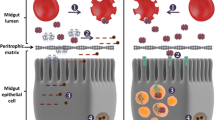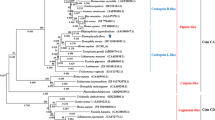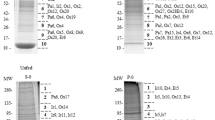Summary
The proteolytic activity of gut extracts prepared from Hyalomma excavatum female ticks was studied at different stages of blood feeding. Proteolytic enzyme activity was shown to be negligible in unfed ticks, increased from the onset of the tick feeding, reached a maximum at 60–70 hours post attachment and then declined to the initial low level. Proteolytic activity seems to be related to the presence of acidic protease(s) with an optimal pH of 2.9. It appears that a proteolytic enzyme inhibitor is present in the gut of the engorged tick which might be responsible for the low activity at the final stage of feeding.
The possible bearing of the proteolytic phenomena on tick borne pathogens is discussed.
Similar content being viewed by others
References
Arthur, D. R.: Ticks and disease. Oxford: Pergamon Press 1962.
Bailey, J. L.: Techniques in protein chemistry, p. 293–304. Amsterdam: Elsevier Publishing Co. 1962.
Gregson, J.: Morphology and functioning of the mouth parts in Dermacentor andersoni stiles. Acta. trop. (Basel) 17, (1), 48–79 (1960).
Hadani, A., Cwilich, R., Rechav, Y., Dinur, Y.: Some methods for the breeding of ticks in the laboratory. Refuah vet. 26, 87–100 (1969).
House, H. L.: In: The physiology of insects (M. Rockstein, ed.). New York: Academic Press 1965.
Hughes, T. E.: Some histological changes which occur in the gut epithelium of Ixodes ricinus females during gorging and up to oviposition. Ann. trop. Med. Parasit. 48, 397–404 (1954).
Kitaoka, S.: Physiological and ecological studies on some ticks. VI. Data of digestion of blood meal and nitrogen, iron and sterol economy during the ovipositing process in the tick. Nat. Inst. anim. Hlth Quart. 1, 105–112 (1961).
Lees, A. D.: The role of the cuticle growth in the feeding process of ticks. Proc. Zool. Soc. London 121, 759–772 (1952).
Martin, H. M., Barnett, S. F., Vidler, B. O.: Cyclic development and longevity of Theileria parva in the tick Rhipicephalus appendiculatus. Exp. Parasit. 15, 527–555 (1964).
Mycek, M. J.: In: Methods in enzymology. Proteolytic enzymes (G. E. Perlmann and L. Lorand, editors), vol. 19, p. 285–315. New York-London: Academic Press 1970.
Riek, R. F.: The life cycle of Babesia bigemina (Smith and Kilborne, 1893) in the tick vector Boophilus microplus (Conestrini). Aust. J. agric. Res. 15, 802–821 (1961).
Roesler, R.: Histologische, physiologische und serologische Untersuchungen über die Verdauung bei der Zeckengattung Ixodes lat. Z. Morph. Ökol. Tiere 28, 297–317 (1934).
Sutton, E., Arthur, D. R.: Aspects of disease transmission by ticks. In: Symposia of the Zoological Society of London 6, 223–252 (1962).
Tatchell, R. J.: Digestion in the tick Argas persicus Oken. Parasitology 54, 423–440 (1964).
Till, V. M.: A contribution to the anatomy and histology of the brown ear tick Rhipicephalus appendiculatus Neumann. Mem. ent. Soc. S. Afr. 6, 1–124 (1961).
Author information
Authors and Affiliations
Rights and permissions
About this article
Cite this article
Bogin, E., Hadani, A. Digestive enzymes in “hard ticks” (ixodoidea, ixodidae). Z. F. Parasitenkunde 41, 139–146 (1973). https://doi.org/10.1007/BF00328757
Received:
Issue Date:
DOI: https://doi.org/10.1007/BF00328757




